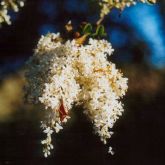Chinese privet

Small leaf privet flower
© Queensland Government

Small leaf privet flowers
© Queensland Government

Small leaf privet plant
© Queensland Government

Small leaf privet leaf and fruit
© Queensland Government
Native to Asia, Chinese privet is a large shrub that has been widely distributed in Australia as a garden hedge plant. In natural systems, its densely branched growth habit poses a significant shading threat to native plants in moist, temperate areas.
You must manage the impacts of Chinese privet on your land.
You must not give away, sell or release Chinese privet into the environment.
Scientific name
Other names
- Small-leaf privet, hedge privet
Similar species
- Native privet (Ligustrum australianum)
Description
- Large shrub up to 4m tall.
- Leaves are deep green, oval shaped, up to 5cm long, with fine hairs.
- Young branches are also covered in fine hairs.
- Flowers are small, scented, in dense, cream sprays up to 10cm long.
- Berries are green when young, ripening to dark-blue to black.
Habitat
- Prefers moist, temperate areas of South East Queensland.
Distribution
- Found along entire Queensland coastline.
Life cycle
- Flowers appear late in winter to spring.
Affected animals
- Humans
- Native animals
Impacts
Environmental
- Poses significant shading threat to native plants in moist, temperate areas of South East Queensland.
- Affects habitat of native animals.
- Hinders animal movement through bushland.
Social
- Flowers can cause severe allergic reactions in humans.
How it is spread
- Berries spread by birds.
Prevention
Control
Physical control
- Hand-pull small plants.
- Do not break tap root or plant will regrow.
Herbicide control
- Treat larger plants with herbicides.
Read the Small leaf or Chinese privet fact sheet (PDF, 3.2MB) for herbicide control and application rates.
Biological control
- No known biological control agents.
Legal requirements
- Chinese privet is a category 3 restricted invasive plant under the Biosecurity Act 2014.
- You must not give away, sell, or release into the environment. Penalties may apply.
- You must take all reasonable and practical measures to minimise the biosecurity risks associated with dealing with Chinese privet under your control. This is called a general biosecurity obligation (GBO).
- At a local level, each local council must have a biosecurity plan that covers invasive plants and animals in its area. This plan may include actions to be taken on Chinese privet. Some of these actions may be required under local laws. Contact your local council for more information.